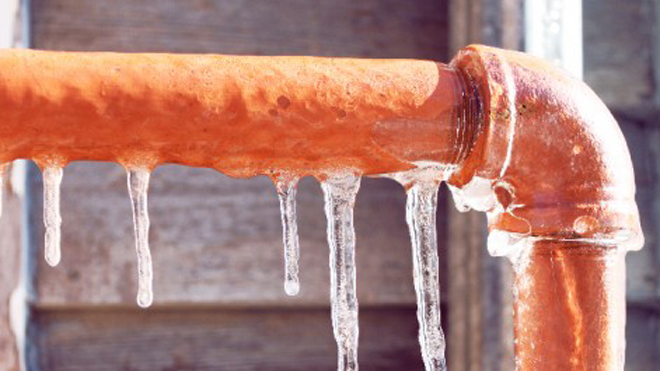Crucial Tips to Avoid Frozen Plumbing in Cold Weather
Crucial Tips to Avoid Frozen Plumbing in Cold Weather
Blog Article
Are you trying to find content involving Preventing and dealing with frozen pipes?
:strip_icc()/snow-outdoor-faucet-pipes-4af65d1e5e904fb1aa7bf74071fe5d89.jpg)
Cold weather can wreak havoc on your pipes, specifically by freezing pipelines. Right here's exactly how to prevent it from happening and what to do if it does.
Introduction
As temperature levels drop, the risk of icy pipelines boosts, potentially resulting in costly fixings and water damages. Understanding just how to avoid icy pipes is critical for property owners in cool environments.
Comprehending Frozen Pipelines
What causes pipelines to freeze?
Pipelines freeze when subjected to temperatures listed below 32 ° F (0 ° C) for expanded periods. As water inside the pipes ices up, it broadens, taxing the pipe walls and potentially causing them to rupture.
Risks and problems
Frozen pipes can lead to water disruptions, building damage, and expensive repair work. Ruptured pipes can flood homes and cause substantial architectural damages.
Signs of Frozen Pipeline
Identifying icy pipelines early can avoid them from bursting.
How to identify frozen pipelines
Seek lowered water circulation from faucets, unusual smells or sounds from pipes, and noticeable frost on subjected pipes.
Prevention Tips
Protecting prone pipes
Wrap pipes in insulation sleeves or utilize heat tape to protect them from freezing temperature levels. Focus on pipes in unheated or external locations of the home.
Home heating techniques
Keep indoor rooms effectively heated up, especially locations with plumbing. Open cupboard doors to permit warm air to circulate around pipes under sinks.
Securing Outside Plumbing
Garden hose pipes and outside taps
Disconnect and drain pipes yard tubes prior to winter. Set up frost-proof faucets or cover exterior taps with shielded caps.
What to Do If Your Pipes Freeze
Immediate actions to take
If you presume icy pipelines, keep taps open to relieve pressure as the ice melts. Make use of a hairdryer or towels soaked in warm water to thaw pipelines gradually.
Long-Term Solutions
Architectural adjustments
Consider rerouting pipes far from outside wall surfaces or unheated areas. Include added insulation to attic rooms, cellars, and crawl spaces.
Updating insulation
Purchase high-grade insulation for pipelines, attics, and wall surfaces. Appropriate insulation helps preserve constant temperature levels and lowers the threat of frozen pipelines.
Conclusion
Stopping icy pipes requires aggressive procedures and quick actions. By recognizing the causes, indicators, and preventive measures, homeowners can secure their pipes throughout winter.
5 Ways to Prevent Frozen Pipes
Drain Outdoor Faucets and Disconnect Hoses
First, close the shut-off valve that controls the flow of water in the pipe to your outdoor faucet. Then, head outside to disconnect and drain your hose and open the outdoor faucet to allow the water to completely drain out of the line. Turn off the faucet when done. Finally, head back to the shut-off valve and drain the remaining water inside the pipe into a bucket or container. Additionally, if you have a home irrigation system, you should consider hiring an expert to clear the system of water each year.
Insulate Pipes
One of the best and most cost-effective methods for preventing frozen water pipes is to wrap your pipes with insulation. This is especially important for areas in your home that aren’t exposed to heat, such as an attic. We suggest using foam sleeves, which can typically be found at your local hardware store.
Keep Heat Running at 65
Your pipes are located inside your walls, and the temperature there is much colder than the rest of the house. To prevent your pipes from freezing, The Insurance Information Institute suggests that you keep your home heated to at least 65 degrees, even when traveling. You may want to invest in smart devices that can keep an eye on the temperature in your home while you’re away.
Leave Water Dripping
Moving water — even a small trickle — can prevent ice from forming inside your pipes. When freezing temps are imminent, start a drip of water from all faucets that serve exposed pipes. Leaving a few faucets running will also help relieve pressure inside the pipes and help prevent a rupture if the water inside freezes.
Open Cupboard Doors
Warm your kitchen and bathroom pipes by opening cupboards and vanities. You should also leave your interior doors ajar to help warm air circulate evenly throughout your home.

Do you enjoy more info about How to Prevent Your Pipes From Freezing? Leave a remark down below. We will be delighted to listen to your opinion about this blog posting. We are looking forward to see you back again soon. In case you enjoyed our page plz be sure to share it. I praise you for being here. Please come by our blog back soon.
Find Out More Report this page